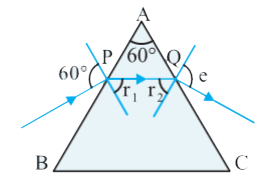A ray of light is incident at an angle of 60∘ on the face of a prism having refracting angle 30∘. The ray emerging out of the prism makes an angle 30∘ with the incident ray. Show that the emergent ray is perpendicular to the face through which it emerges.
The correct Answer is:A, C, D
To solve the problem step by step, we will use the concepts of refraction through a prism.
Step 1: Identify the given values
- Angle of incidence (I₁) = 60°
- Refracting angle of the prism (A) = 30°
- Angle of deviation (Δ) = 30° (the angle between the incident ray and the emergent ray)
Step 2: Use the formula for angle of deviation in a prism
The formula for the angle of deviation (Δ) in a prism is given by:
Δ=I₁+I₂−A
Where:
- Δ is the angle of deviation
- I₁ is the angle of incidence
- I₂ is the angle of refraction at the second face of the prism
- A is the angle of the prism
Step 3: Substitute the known values into the formula
We know:
- Δ = 30°
- I₁ = 60°
- A = 30°
Substituting these values into the formula:
30°=60°+I₂−30°
Step 4: Simplify the equation to find I₂
Rearranging the equation gives:
I₂=30°−60°+30°
I₂=0°
Step 5: Interpret the result
An angle of refraction (I₂) of 0° means that the emergent ray is perpendicular to the face of the prism through which it emerges. This is because if I₂ is 0°, it indicates that the ray is emerging straight out of the prism without bending.
Conclusion
Thus, we have shown that the emergent ray is perpendicular to the face through which it emerges.
---
- Angle of incidence (I₁) = 60°
- Refracting angle of the prism (A) = 30°
- Angle of deviation (Δ) = 30° (the angle between the incident ray and the emergent ray)
The formula for the angle of deviation (Δ) in a prism is given by:
Δ=I₁+I₂−A
Where:
- Δ is the angle of deviation
- I₁ is the angle of incidence
- I₂ is the angle of refraction at the second face of the prism
- A is the angle of the prism
We know:
- Δ = 30°
- I₁ = 60°
- A = 30°
30°=60°+I₂−30°
Rearranging the equation gives:
I₂=30°−60°+30°
I₂=0°
An angle of refraction (I₂) of 0° means that the emergent ray is perpendicular to the face of the prism through which it emerges. This is because if I₂ is 0°, it indicates that the ray is emerging straight out of the prism without bending.
Thus, we have shown that the emergent ray is perpendicular to the face through which it emerges.
Topper's Solved these Questions
- REFRACTION OF LIGHTBOOK - DC PANDEY ENGLISHCHAPTER - REFRACTION OF LIGHTEXERCISE - Exercise 31.1
3 Videos
- REFRACTION OF LIGHTBOOK - DC PANDEY ENGLISHCHAPTER - REFRACTION OF LIGHTEXERCISE - Exercise 31.2
2 Videos
- REFRACTION OF LIGHTBOOK - DC PANDEY ENGLISHCHAPTER - REFRACTION OF LIGHTEXERCISE - Example Type 11
3 Videos
- REFLECTION OF LIGHTBOOK - DC PANDEY ENGLISHCHAPTER - REFLECTION OF LIGHTEXERCISE - Subjective
9 Videos
- SEMICONDUCTORSBOOK - DC PANDEY ENGLISHCHAPTER - SEMICONDUCTORSEXERCISE - Subjective
12 Videos
Similar Questions
A ray of light is incident at an angle of 60∘ on one face of a prism of angle 30∘. The ray emerging out of the prism makes an angle of 30∘ with the incident ray. The emergent ray is
View SolutionA ray of light is incident at an angle of 60∘ on one face of a prism which has refracting angle of 30∘ . The ray emerging out of the prism makes an angle of 30∘ with the incident ray. If the refractive index of the material of the prism is μ=√a , find the value of a .
View Solution
Knowledge Check
A ray of light is incident at 60∘ on one face of a prism of angle 30∘ and the emergent ray makes 30∘ with the incident ray. The refractive index of the prism is
A1.732B1.414C1.5D1.33
A Ray of light is incident at an angle 60° on one face of a prism which has protecting angle of 30°. The emerging ray deviates through 30° from incident light. The refractive index of material of prism is
View SolutionA ray of light is incident on one face of a prism (m=√3) at an angle of 60∘. The refracting angle of the prism is also 60∘. Find the angle of emergence .

View SolutionA light ray is incident by grazing one of the face of a prism and after refraction ray does not emerge out, what should be the angle of prism while critical angle is C ?
View SolutionA ray of light is incident normally on one of the faces of a prism of apex angle 30 degree and refractive index √2. The angle of deviation of the ray in degrees is
View SolutionA ray of light is incident at 60∘ on one face of a prism of angle 30∘ and the emergent ray makes 30∘ with the incident ray. The refractive index of the prism is
View SolutionA ray of light is incident at 65∘ on one face of a prism of angle of 30∘ and the emergent ray makes 35∘ with the incident ray. The refractive index of the prism is:
View SolutionA ray of light incident at an angle 90° with the face of an equilateral prism passes symmetrically. Calculate the refractive index of the material of the prism
View Solution
